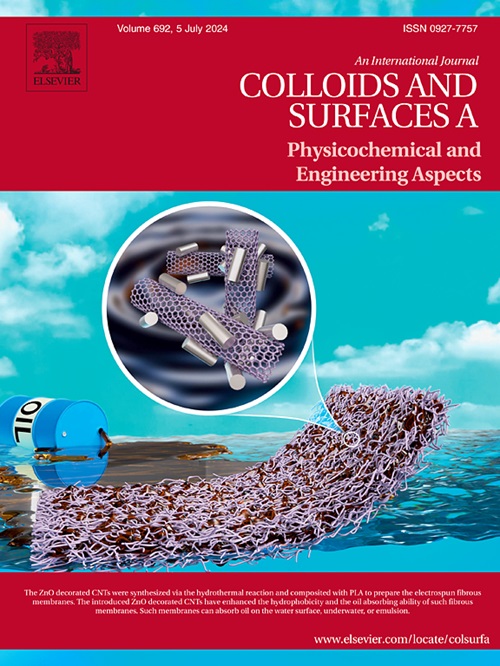Comprehensive study on the physical and electrochemical behavior of Mn₀.₄Mg₀.₆Fe₂O₄/CeO₂/MnFe₂O₄ nanocomposite for energy storage applications
IF 5.4
2区 化学
Q2 CHEMISTRY, PHYSICAL
Colloids and Surfaces A: Physicochemical and Engineering Aspects
Pub Date : 2025-07-16
DOI:10.1016/j.colsurfa.2025.137748
引用次数: 0
Abstract
A novel Mn₀.₄Mg₀.₆Fe₂O₄/CeO₂/MnFe₂O₄ nanocomposite was created and thoroughly examined for its structural, morphological, chemical, and electrochemical attributes, particularly for energy storage applications. XRD analysis confirms the coexistence of CeO₂, MnFe₂O₄, and MgFe₂O₄ crystalline phases, indicating the formation of a well-integrated multiphase composite. Electron microscopy (FESEM and TEM) reveals agglomerated, irregularly shaped nanoparticles with an average size of 13–14 nm, while EDS and elemental mapping confirm the uniform distribution of Mg, Mn, Ce, Fe, and O within the structure. Zeta potential measurements (∼ –22.7 mV) suggest good colloidal stability, and DLS analysis indicates the presence of larger particle agglomerates. XPS analysis identifies the constituent elements and confirms the presence of multiple oxidation states (Mn²⁺/Mn³⁺, Ce³⁺/Ce⁴⁺, Fe²⁺/Fe³⁺), pointing to the redox-active nature of the material. EPR spectroscopy shows a resonance signal with a g-factor of 2.48, indicating the presence of unpaired electrons typical of transition metal ions. Electrochemical characterization via cyclic voltammetry (CV) demonstrates pronounced pseudocapacitive behavior driven by surface redox reactions, while galvanostatic charge-discharge (GCD) profiles exhibit near-ideal triangular shapes and minimal internal resistance, reflecting good rate capability and efficient charge storage. These findings underscore the material's potential as a promising candidate for high-performance supercapacitor electrodes, offering a balance between energy and power density through its synergistic multi-phase composition and favorable electrochemical response.
硫酸镁0的物理和电化学行为的综合研究。₆Fe₂O₄/CeO₂/MnFe₂O₄纳米复合材料,用于储能应用
一种新的Mn 0,₄Mg 0。₆Fe₂O₄/CeO₂/MnFe₂O₄纳米复合材料被制成,并对其结构、形态、化学和电化学特性进行了彻底的研究,特别是在储能应用方面。XRD分析证实了ceo2、MnFe₂O₄和MgFe₂O₄晶相的共存,表明形成了一种完整的多相复合材料。电子显微镜(FESEM)和透射电镜(TEM)显示,纳米颗粒聚集,形状不规则,平均尺寸为13-14 nm,而EDS和元素映射证实了结构内Mg, Mn, Ce, Fe和O的均匀分布。Zeta电位测量值(~ -22.7 mV)表明胶体稳定性良好,DLS分析表明存在较大的颗粒团块。XPS分析鉴定了组成元素,并确认了多种氧化态(Mn²+ /Mn³+、Ce³+ /Ce⁴+、Fe²+ /Fe³+)的存在,指出了材料的氧化还原活性。EPR谱显示出一个共振信号,其g因子为2.48,表明存在典型过渡金属离子的不成对电子。通过循环伏安法(CV)进行的电化学表征表明,表面氧化还原反应驱动了明显的赝电容行为,而恒流充放电(GCD)曲线呈现出接近理想的三角形形状和最小的内阻,反映了良好的倍率能力和高效的电荷存储。这些发现强调了该材料作为高性能超级电容器电极的潜力,通过其协同多相组成和良好的电化学响应,提供了能量和功率密度之间的平衡。
本文章由计算机程序翻译,如有差异,请以英文原文为准。
求助全文
约1分钟内获得全文
求助全文
来源期刊
CiteScore
8.70
自引率
9.60%
发文量
2421
审稿时长
56 days
期刊介绍:
Colloids and Surfaces A: Physicochemical and Engineering Aspects is an international journal devoted to the science underlying applications of colloids and interfacial phenomena.
The journal aims at publishing high quality research papers featuring new materials or new insights into the role of colloid and interface science in (for example) food, energy, minerals processing, pharmaceuticals or the environment.

 求助内容:
求助内容: 应助结果提醒方式:
应助结果提醒方式:


